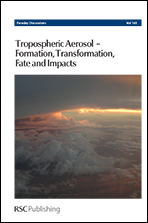The concurrent presence of high values of organic SOA precursors and reactive halogen species (RHS) at very low ozone concentrations allows the formation of halogen-induced organic aerosol, so-called XOA, in maritime areas where high concentrations of RHS are present, especially at sunrise. The present study combines aerosol smog-chamber and aerosol flow-reactor experiments for the characterization of XOA. XOA formation yields from α-pinene at low and high concentrations of chlorine as reactive halogen species (RHS) were determined using a 700 L aerosol smog-chamber with a solar simulator. The chemical transformation of the organic precursor during the aerosol formation process and chemical aging was studied using an aerosol flow-reactor coupled to an FTIR spectrometer. The FTIR dataset was analysed using 2D correlation spectroscopy. Chlorine induced homogeneous XOA formation takes place at even 2.5 ppb of molecular chlorine, which was photolysed by the solar simulator. The chemical pathway of XOA formation is characterized by the addition of chlorine and abstraction of hydrogen atoms, causing simultaneous carbon–chlorine bond formation. During further steps of the formation process, carboxylic acids are formed, which cause a SOA-like appearance of XOA. During the ozone-free formation of secondary organic aerosol with RHS a special kind of particulate matter (XOA) is formed, which is afterwards transformed to SOA by atmospheric aging or degradation pathways.
You have access to this article
 Please wait while we load your content...
Something went wrong. Try again?
Please wait while we load your content...
Something went wrong. Try again?

 Please wait while we load your content...
Please wait while we load your content...